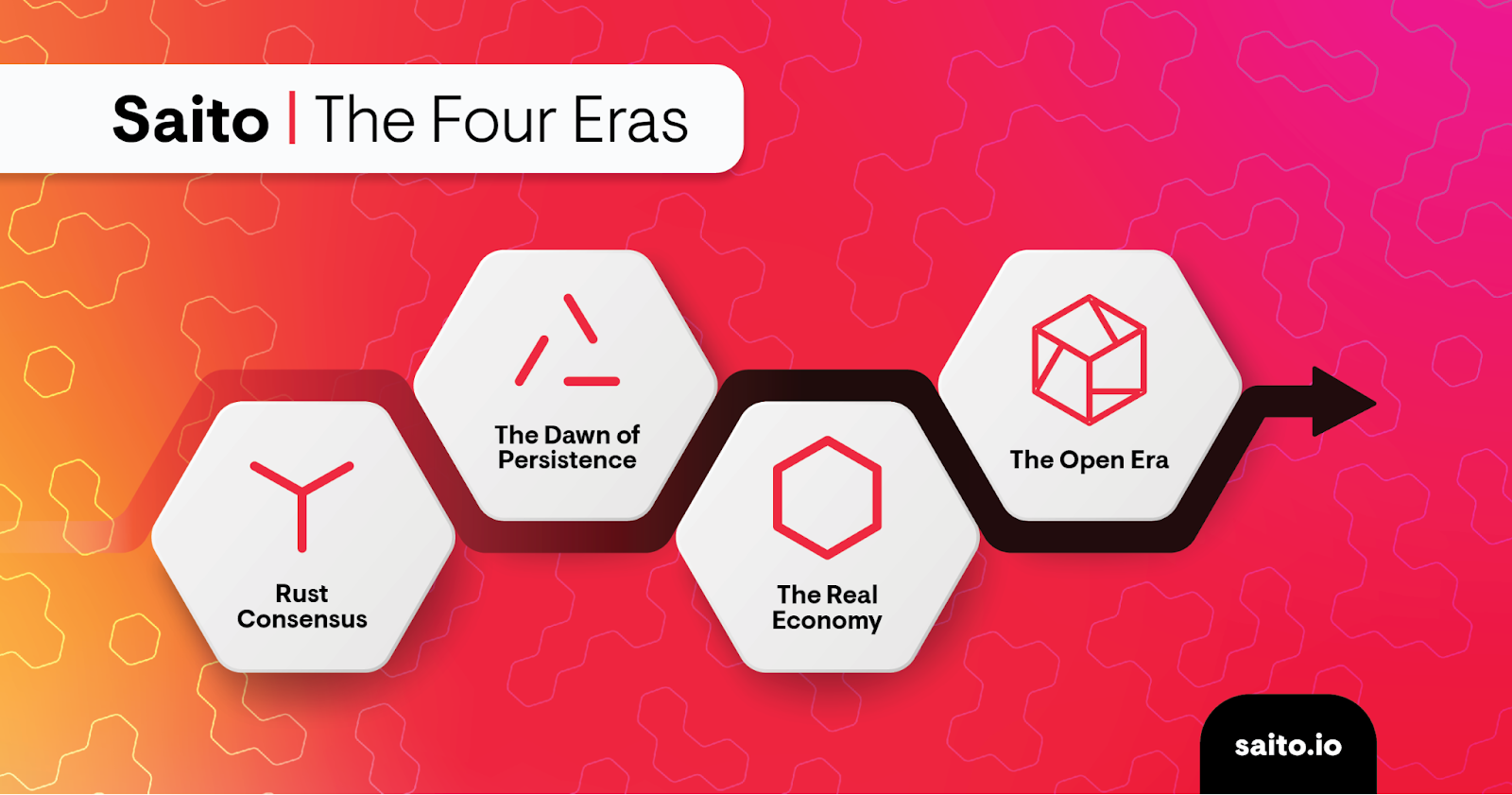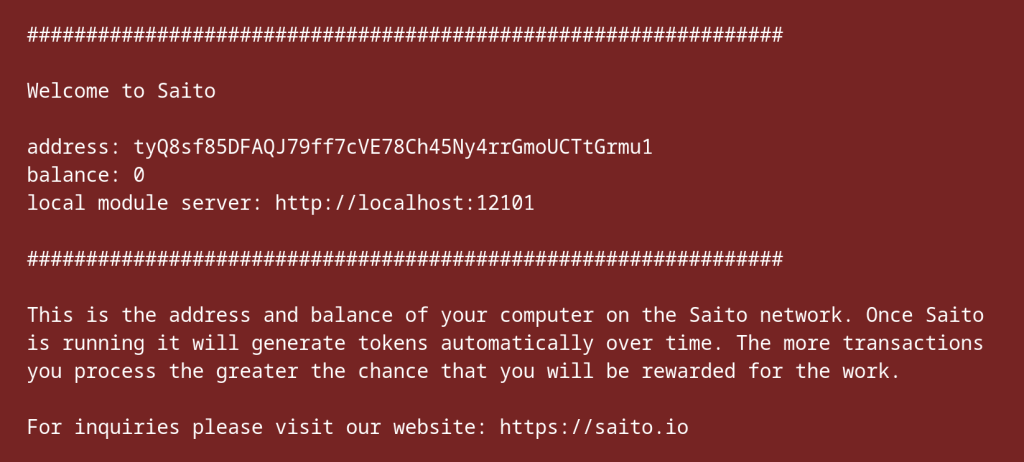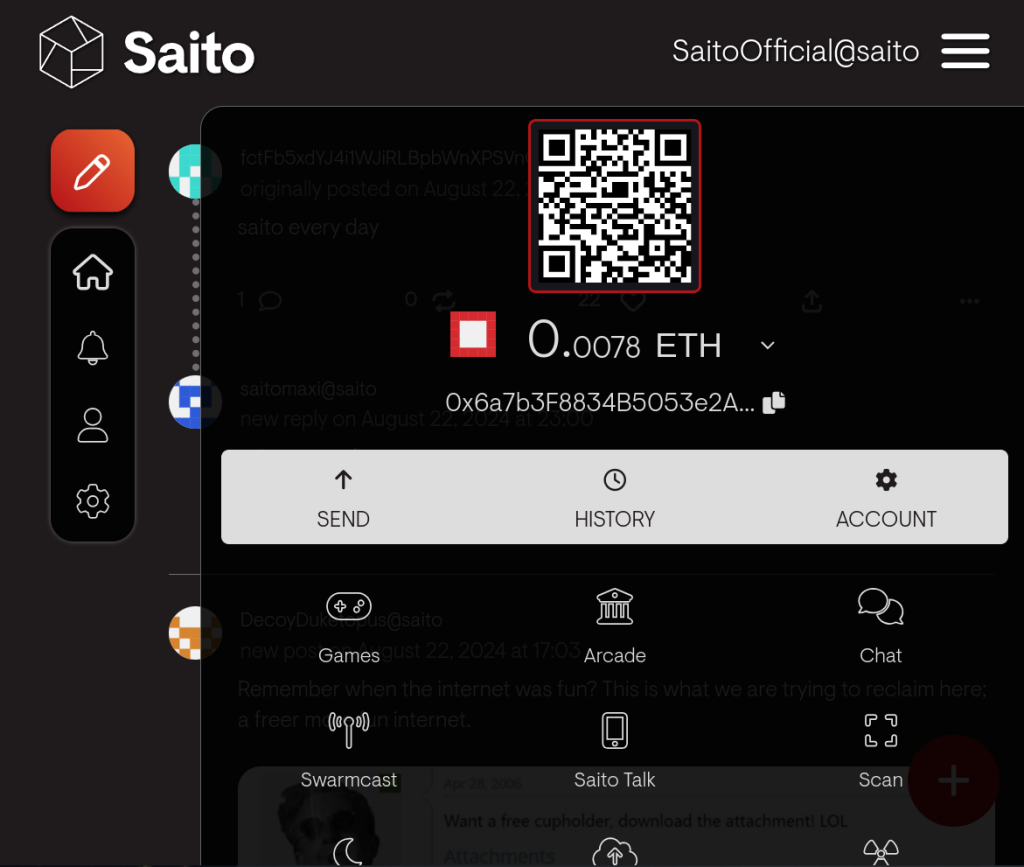Saito Summer 12 – The Big Picture
Watch the complete Saito Summer 12 Space, hosted on Swarmcast and uploaded to YouTube.
Roadmap

The First Era of Saito saw the development of the Rust Client to place Saito’s most crucial consensus code on a stable and performant foundation (one of rock, not sand).
In Second Era of roadmap – The Dawn of Persistence, the goal has been generating organic transaction volume by building a rich and functional developer and user ecosystem. Apps are both demonstrations of a new paradigm of decentralized PKI, but also genuinely valuable to users.
Data Persistence (read more below) is now a primary focus. We’ve already done much of the work with Archive Nodes to allow peers to connect to the Saito Network and send and receive the data necessary for a rich experience without a server. Work going forward will center around improving those tools.
These core updates to the node software may mean that updates are less frequent and less flashy, but nonetheless and perhaps even more important than the litany of application and feature reveals which have taken place during Saito Summer so far.
Coming off the back of Dynamic Modules, the prospect for Saito application developers today is rich: build and publish an application that functions without the need for you or your users to interact with any central infrastructure, and which is automatically monetizable via Saito’s revolutionary fee system.
Saito Developer Experience

Progress
Saito apps but also to support the wide range of features that will make Web3 more than just marketing – we believe the Saito blockchain and the Web3 services atop it are the foundation for a new way to PKI and a better internet.
Feedback and collaboration with outside developers has led to direct improvements to the Saito development experience. We continue to streamline features which make the transition to Web3 development easier: One of these many features, upgraded recently, is the ability to easily save, load and send peers transaction data. This upgrade is largely responsible for the more seamless than ever P2P experience on Red Square.
The end result of all these tools is a the ability to create P2P networked apps that operate without any central servers. The Saito-Lite-Rust node offers methods such as the storage functionality mentioned above built-in. It’s not always easy transitioning to a Web3 mindset, but when it all clicks the Saito Developer Kit is fully equipped with all the tools you need.
Devs can build a standard web application and then turn it into a true P2P app running on a lite node in the user’s browser without too much trouble. With Dynamic Modules, developers don’t even have to run infrastructure.
Come Build
If you’re interested in building an application like this, Saito is your best option. We’ve completely revamped our Wiki with better documentation and several up-to-date tutorials.
The team is also happy to offer direct support in getting developers up to speed working with Saito. A big part of this stage in the roadmap is understanding the challenges developers face when moving to the Real Web3 paradigm on Saito.
Applications

Red Square
Red Square has gone from a technical demo of P2P (not centralized, not federated – but even more decentralized) social media with a myriad of usability blemishes, to a smooth and fun platform that often distracts us from our work.
During that time, Red Square has also become more decentralized, relying less and less on any central node and capable of providing the aforementioned experience by connecting directly to peers and not being reliant on some central server that privatizes your content and others’ access to it.
And despite giving users more autonomy and freedom, we’ve also developed moderation tools which give every individual the control to completely dictate for themselves what content they want to see. The average user adopts the node’s moderate content policy, but any user can opt out, customize, and share their own moderation policies; since everything is P2P, this level of customization works well even in the early days of this technology.
We are currently developing an integration between our Archive Node tools and User Profiles such that users are able to act as repositories for their own data and data they want to share. In this way, retweeting posts, adding friends and other actions become more than just symbolic – they represent real ways that data flows between peers and puts the power of the platform firmly in the hands of the users.
While these techniques are helping us build an exciting and fun P2P social media network today, they also form the basis of PKI networks of the tomorrow suitable as the base layer of a new class of applications which can’t be centrally captured.
App Store
Dynamic Modules (or Dynamically Compiled Modules – DCM) now makes it possible to share and install Saito applications as small files, which run on your Saito Client in the browser regardless of any permissions given from any server or full node. This is a recent development, so the infrastructure and UX of this process, while functional, is being improved in real time.
While DCM is still used primarily by tinkerers, the technology has removed the most fundamental roadblocks in the development of a P2P App Store which maximizes user freedom and control. We envision this as a model where developers aren’t required to host expensive infrastructure and users are able to easily modify and install new applications.
Of course, the best part is that our vision is just our vision. Anyone who has a different idea of where to take this technology has nothing stopping them from doing so, though we do appreciate our role in laying the groundwork and setting good examples as we pioneer Web3 firsthand.
Realms NFT Card Game
As work on the consensus code accelerates, and our bound-UTXO token model nears completion, our Magic The Gathering-style NFT card game removes more roadblocks. That being said, while much of the artwork has been completed, the team is looking for those willing to take some initiative and manage the revival of its development, like assets and basic code, to meetup with the release of native NFTs and tokens on Saito.
Settlers of Saitoa and Other Games
Settlers game play and UI has been improved through multiple recent iterations. Smoother and more polite info boxes have put our old pop-up style modals to shame enough to be adopted across more titles in our suite of P2P Games. While small changes, we don’t take for granted that whether the underlying architecture is legacy Web2 or Saito’s Advanced P2P Game Engine, users expect a premium interface. Despite the nuances involved in making cryptographically secure, stable, and fast P2P games, Saito’s Development Kit makes these UI/UX improvements simple.
Some unreleased games are also nearing completion, so look forward to those! If you’d like to develop a game on Saito, get started with our tutorials.
Archive Nodes
Archive Nodes support decentralized data ownership and access of data in an environment of primarily P2P-connected clients. Much of the challenge of leaving the server-client centralized model behind is tackled by Archive Nodes.
Separate from Token Persistence, Data Persistence has been a large focus from the development side recently. Data Persistence just means that important data, be it authentication data or user generated content, is available to network participants from a variety of different sources and not a central bottleneck or checkpoint.
As mentioned earlier, Archive Node is a term being used to describe peers and nodes on the network who can hold and share such arbitrary data in a way that doesn’t allow them to fabricate or impersonate other users. This is an important service to offer to trusted peers and potentially fee-paying strangers alike – the system is designed to accommodate both ends of that spectrum and everything in between. As applications rely less and less on full nodes to operate, our Archive Node tooling proves its worth more and more.
The monetization opportunities for Archive Nodes have the potential to democratize the business of online storage; users can encrypt their data for a more secure experience than services like Google Drive. At the same time, the ability to host the content of other users and get paid for it will apply to any participant on the network, greatly expanding past the Web2 market for storage.
Saito Blog Module
A future flagship demonstration of Archive Nodes is our under-development Saito Blog Module, which will allow decentralized hosting for rich-text content. Saito hosts its livestreams on Swarmcast, our community discussions on Red Square and Chat – it only makes sense that we move these blog posts on-chain and firmly into Web3 alongside.
Anyone who wants to start a blog and doesn’t want to worry about infrastructure, censorship or the hurdles of the legacy internet will of course be invited to join us as this module rolls out.
Core Node Software & Consensus
More developer work over the last few weeks has gone into our Core Rust Node, and as the work to improve applications call upon more improvements to the Core Rust Node Software, the community can expect more updates and upgrades of this nature. We are ahead of the roadmap on the Token Persistence Curve and will consider accelerating the pace at which the network supports smaller and smaller token balances as development progresses.
First-Class Networking
Saito clients work by connecting to a full node, downloading the client software, and then running the client software to finally make P2P connections. As the Rust layer has received more development, one of the upgrades for Saito Clients has been moving the P2P connections out of the NodeJS code and into WASM Rust code.
Where previously establishing these P2P connections for users required some mediation from a helpful full node, the Swarm style connections made directly and without intermediation used between full nodes is now available to all users on Saito. This greatly increases the ability to interact with peers on the network and further decentralizes all user activities on Saito Web3.
Security at Low Fee-Volume
Saito is non-inflationary, so tokens are not printed to prop-up network security like in Bitcoin. We have therefore developed an anti-joyriding mechanism to prevent the most threatening attack vectors Saito might face before it garners enough fee-volume to secure itself automatically. This security feature is currently implemented and soon to be turned on.
Though work on this takes place behind the scenes, and most outward focus is on the applications, this network upgrade represents a significant step forward on the roadmap as it opens up the door for all manner of financial activity on Saito, including moving the Token Persistence Curve further down and securely supporting wealth transfers in native Saito tokens.
NFTs, Bound-UTXOs, Tokens
A Saito NFT is a special UTXO that is bound to another UTXO that has fees and can be transferred normally.
The bound-UTXO thus always moves with the standard transaction, providing a flexible and simple NFT standard for Saito Mainnet. This is a technique unique to Saito which results in some desirable advantages:
1. NFTs are lighter and cheaper to create and send.
2. “Split NFTs” are possible, defining a fungible token standard within the Bound-UTXO framework
The standard is under development and currently under testing. Progress can be tracked on Github. We thank the developers eagerly awaiting this feature for their patience, and share your excitement in seeing what the community builds.
ATR Hyperloop
Our position in the roadmap and the Token Persistence Curve are closely related, and we are slightly ahead of schedule on both. In the interest of carrying that momentum forward, the team is internally considering putting the network into an ATR Hyperloop where the epoch for Automatic Transaction Rebroadcasting (ATR) is significantly shortened.
By accelerating the rate of ATR, the number of ATR cycles will increase and give much more information to core developers how this novel system is faring in production. Any issues can identified and ameliorated, and the increased pace will speed this development process so that Saito can handle larger volumes of transaction data sooner.
This will have big implications for applications. As more data and tokens persist on the network, users have an easier time hosting their data on-chain and developers building applications that can live without help from a node or server. Token and Data Persistence are set to move Saito forward in the roadmap and place it even further ahead of any potential competition.
Conclusion
Saito is on pace with the roadmap laid out years ago, and even slightly ahead of schedule. We plan to carry this momentum forward, not coast, and get Saito even further along the roadmap at a faster pace than previously anticipated.
All of this on the back of a massively successful, and still ongoing, Saito Summer campaign which has opened opportunities for third-party developers and expanded our on-chain ecosystem. Work in the coming months will shift to core consensus client and node software to improve Saito’s Token and Data Persistence. This work will even further enhance the openness and freedom afforded to Saito applications.
If you have any questions, bring them to Red Square or, if you are old-school, Telegram. For anyone wondering what Saito has been up to and where it’s going, this is a great post to share with them!



